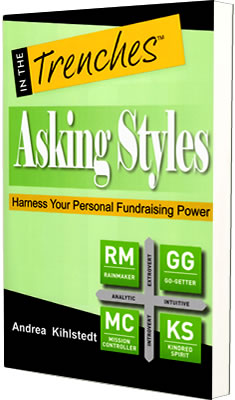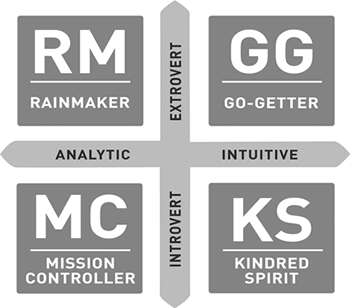 As we approach “the ask” in the Major Gifts Challenge, I’ve asked my colleague, Andrea Kihlstedt, to prepare a guest post for this week dedicated to Asking Styles.
As we approach “the ask” in the Major Gifts Challenge, I’ve asked my colleague, Andrea Kihlstedt, to prepare a guest post for this week dedicated to Asking Styles.
Andrea’s unique approach to asking could really help as you approach your asks. Asking Styles is also the name of Andrea’s new book (pictured right), for which I had the honor of writing the foreword, as well as helping to edit.
“My meeting today was a success! Karen and her husband have offered $2,000 as the first splash in the bucket! It went well and although I was very nervous, the meeting itself felt very positive.”
— Theresa W.
Was she nervous? Yes!
But she was also successful.
That was Theresa’s very first fundraising ask. And in one ask, she raised more than 10% of her $15,000 fundraising goal. Worth overcoming her nervousness? You bet!
Was it Beginner’s Luck?
Was Theresa’s success with her ask just beginner’s luck?
Not in the least.
She had organized her approach, developed her case, identified people who were ready to be asked. And then, whew…. she actually went and asked them for a gift… in person… face to face!
So how did she get over her fear?
Theresa approached the ask in the way that fits her temperament. She’s a person who plans carefully and attends to detail. She likes to study and be fully prepared, so she made sure her material was all in order.
She learned everything she could about asking. She thought through the meeting in advance even calling me to discuss the options in great detail and actually writing out a script. Then she took a deep breath and called Karen to schedule the meeting.
Was she nervous? Yes. Incapacitated? No.
She simply did what she needed to do to get her through her anxiety.
But not everyone’s style is like Theresa’s. In fact many very successful askers are not detail people at all. They prefer bullet points to scripts. They work with big ideas rather than specific facts.
To help you get over your anxiety about asking, I’d like to introduce you to a system of Asking Styles that will help you know how to ask for gifts in the way that suits you best.
The Four Asking Styles – Which are You?
The Asking Styles system is simple and easy to remember. Based on two axes, the system sorts people into four primary styles.
 Start with the vertical axis. Are you an extrovert or an introvert – are you energized by interacting with others, or do you need alone time to charge your inner batteries?
Start with the vertical axis. Are you an extrovert or an introvert – are you energized by interacting with others, or do you need alone time to charge your inner batteries?
Then add the horizontal axis. Are you intuitive — a deductive thinker who comes up with ideas and then examines the facts? Or are you analytical — an inductive thinker who does research before shaping your ideas?
Combine these two axes to find the four Asking Styles:
- Rainmaker (RM)
- Go-Getter (GG)
- Kindred Spirit (KS)
- Mission Controller (MC)
Each style is quite distinct, and each brings different strengths to the fundraising table. Knowing your own Asking Style will help you understand the approach thats most comfortable and effective for you.
If you find yourself thinking you have a foot in more than one Asking Style, don’t worry; Asking Styles are a continuum, not a set of absolutes.
For example, your primary style may be Mission Controller (analytic introvert) but you may also share characteristics of a Kindred Spirit or a Rainmaker.
Take a look at the simple descriptions in the table below and see which of the styles seem to best describe you:

Knowing the different Asking Styles — and knowing which one most closely describes your personality — will give you a clearer sense of everything from deciding which prospects are best for you to choosing how to prepare your ask, conducting the solicitation and even following up with the donor.
In fact, after working with this approach for several years — and writing
a book about it — I’ve found that consciously employing Asking Styles can have a positive impact on virtually all aspects of the fundraising process, from choosing solicitation teams to pairing fundraisers with donors.
The key to asking is knowing (and being) yourself!
Once you are clear about how to use the real you when asking, you’ll find, just as Theresa did, that you, too, can get beyond your natural nervousness. And when you do, you’ll naturally raise more money.
Keep Theresa in mind. A single in-person ask (her first) raised more than 10% of her goal. That sure beats waiting for small checks to come in the door.
Action Item of the Week — 2 hours or less
This week, take the short 30-question Asking Styles Assessment on the Asking Matters website to determine your Asking Style. You’ll get the results online immediately.
Once you discover your Asking Style, give some thought to how it might change the way you think about asking for major gifts. Try to get your ED and or Board President to take the Asking Styles Assessment too. Asking Styles can be a great tool for collaborating with other fundraisers, too.
So what’s your Asking Style? And how do you think you can you apply it to asking for major gifts? Tell us in the comments.
Get the Book on Asking Styles
Asking Styles: Harness Your Personal Fundraising Power debunks the myth that there’s one right way to ask for a gift. When you read about this easy-to-remember system of Asking Styles, you will identify your natural strengths and learn apply them to the sometimes daunting task of asking for gifts. You’ll learn how to work with people of other styles and even how to use Asking Styles to help your board become more comfortable in their roles as fundraisers.
I’d like to point out that I do receive a small amount of money for each sale of Andrea’s book through my website. But I wouldn’t be recommending this book if I didn’t believe it could be such an excellent resource. It’s definitely worth a read if you’re anxious about the ask.

I am a Rain Maker with a secondary Go-Getter style. I enjoy the challenge of fundraising, the planning of the ask, the actual relationship building involved, the process of the ask itself and the follow through, If I get a no, which I rarely do, I see that as an invitation to more relationship building or that my ask was too high or inappropriate, So I explore more and offer alternatives. Knowing my organization and how it fits into the marketplace helps me position my organization well. And taking the time to get to know my donors and their needs and priorities helps me match what they want to do with what I can offer to meet their needs.
Joanne, You Rock! Keep up the great work. So glad you are part of the MG Challenge!